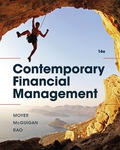
a)
To discuss: The impact of sale of additional common stock and uses those proceeds to increase inventory and to increase cash balances on company’s current ratio.
b)
To discuss: The impact of sale of additional common stock and uses those proceeds to increase inventory and to increase cash balances on company’s
c)
To discuss: The impact of sale of additional common stock and uses those proceeds to increase inventory and to increase cash balances on company’s quick ratio.
d)
To discuss: The impact of sale of additional common stock and uses those proceeds to increase inventory and to increase cash balances on company’s debt to total assets.
e)
To discuss: The impact of sale of additional common stock and uses those proceeds to increase inventory and to increase cash balances on company’s total asset turnover.
Want to see the full answer?
Check out a sample textbook solution
Chapter 3 Solutions
EBK CONTEMPORARY FINANCIAL MANAGEMENT
 EBK CONTEMPORARY FINANCIAL MANAGEMENTFinanceISBN:9781337514835Author:MOYERPublisher:CENGAGE LEARNING - CONSIGNMENT
EBK CONTEMPORARY FINANCIAL MANAGEMENTFinanceISBN:9781337514835Author:MOYERPublisher:CENGAGE LEARNING - CONSIGNMENT Cornerstones of Financial AccountingAccountingISBN:9781337690881Author:Jay Rich, Jeff JonesPublisher:Cengage Learning
Cornerstones of Financial AccountingAccountingISBN:9781337690881Author:Jay Rich, Jeff JonesPublisher:Cengage Learning Intermediate Financial Management (MindTap Course...FinanceISBN:9781337395083Author:Eugene F. Brigham, Phillip R. DavesPublisher:Cengage Learning
Intermediate Financial Management (MindTap Course...FinanceISBN:9781337395083Author:Eugene F. Brigham, Phillip R. DavesPublisher:Cengage Learning- Principles of Accounting Volume 2AccountingISBN:9781947172609Author:OpenStaxPublisher:OpenStax College

 Financial AccountingAccountingISBN:9781337272124Author:Carl Warren, James M. Reeve, Jonathan DuchacPublisher:Cengage Learning
Financial AccountingAccountingISBN:9781337272124Author:Carl Warren, James M. Reeve, Jonathan DuchacPublisher:Cengage Learning





